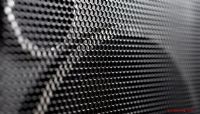
Wetenschap
Natuurkundigen hebben een microlaser gemaakt die twee cirkelvormige stralen uitzendt

Verkregen afstembare microlaser die twee stralen uitstraalt. De bundels zijn circulair gepolariseerd en onder verschillende hoeken gericht. Credit:Mateusz Krol, Faculteit der Natuurkunde, Universiteit van Warschau
Wetenschappers van de Universiteit van Warschau, de Militaire Technische Universiteit en de Universiteit van Southampton presenteerden een nieuw type afstembare microlaser die twee stralen uitstraalt. "Deze bundels zijn circulair gepolariseerd en onder verschillende hoeken gericht", zegt prof. Jacek Szczytko van de Faculteit der Natuurkunde van de Universiteit van Warschau. Deze prestatie werd verkregen door de zogenaamde persistent-spin-helix op het oppervlak van de microholte te creëren. De resultaten zijn gepubliceerd in Physical Review Applied .
Om dit effect te bereiken, vulden wetenschappers de optische microholte met een vloeibaar kristal gedoteerd met een organische laserkleurstof. De microholte bestaat uit twee perfecte spiegels die dicht bij elkaar zijn geplaatst - op een afstand van 2-3 micron - zodat er binnenin een staande elektromagnetische golf wordt gevormd. De ruimte tussen de spiegels was gevuld met een speciaal optisch medium - vloeibaar kristal - dat bovendien was georganiseerd met een speciale spiegelcoating.
"Het karakteristieke kenmerk van vloeibare kristallen zijn hun langwerpige moleculen en, figuurlijk gesproken, ze werden 'gekamd' op het oppervlak van de spiegels en konden opstaan onder invloed van een extern elektrisch veld, waardoor ook andere moleculen die de holte vullen draaien, "zegt eerste auteur, Marcin Muszynski, van de Faculteit der Natuurkunde van de Universiteit van Warschau.
Het licht in de holte interageert op verschillende manieren met de moleculen wanneer het elektrische veld van de zich voortplantende golf langs de moleculen oscilleert en wanneer de oscillaties er loodrecht op staan. Het vloeibare kristal is een dubbelbrekend medium - het kan worden gekenmerkt door twee brekingsindexen, die afhankelijk zijn van de richting van de elektrische veldoscillaties (d.w.z. de zogenaamde elektromagnetische golfpolarisatie).
De precieze rangschikking van moleculen in de lasermicroholte, verkregen aan de Military University of Technology, resulteerde in het verschijnen van twee lineair gepolariseerde lichtmodi in de holte, d.w.z. twee staande lichtgolven met tegengestelde lineaire polarisaties. Het elektrische veld veranderde de oriëntatie van de moleculen in de optische holte, waardoor de effectieve brekingsindex van de vloeibare kristallagen veranderde. Zo controleerde het de lengte van het zogenaamde optische pad van licht - het product van de breedte van de holte en de brekingsindex waarvan de energie (kleur) van het uitgestraalde licht afhangt. One of the modes did not change its energy as the molecules rotated, while the energy of the other increased as the orientation of the molecules changed.
By optically stimulating the organic dye placed between the molecules of the liquid crystal, a lasing effect was obtained—coherent light radiation with a strictly defined energy. The gradual rotation of the liquid crystal molecules led to unexpected properties of this lasing. The lasing was achieved for this tunable mode:The laser emitted one linearly polarized beam perpendicular to the surface of the mirrors. The use of liquid crystals allowed for a smooth tuning of the light wavelength with the electric field by as much as 40 nm.
"However, when we rotated the liquid crystal molecules so that both energy of modes—the one sensitive to the orientation of the molecules and the one that did not change its energy—overlapped (that is, they were in resonance), the light emitted from the cavity suddenly changed its polarization from linear to two circular:right- and left-handed, with both circular polarities propagating in different directions, at an angle of several degrees," says Prof. Jacek Szczytko, from the Faculty of Physics of the University of Warsaw.
The phase coherence of the laser has been confirmed in an interesting way. "The so-called persistent-spin helix—pattern of stripes with different polarization of light, spaced 3 microns apart—appeared on the surface of the sample. Theoretical calculations show that such a pattern can be formed when two oppositely polarized beams are phase coherent and both modes of light are inseparable—this phenomenon is compared to quantum entanglement," explains Marcin Muszynski.
So far, the laser works in pulses because the organic dye that was used slowly photodegrades under the influence of intensive light. Scientists hope that replacing the organic emitter with more durable polymers or inorganic materials (e.g., perovskites) will allow for longer lifetime.
"The obtained precisely tunable laser can be used in many fields of physics, chemistry, medicine and communication. We use nonlinear phenomena to create a fully optical neuromorphic network. This new photonic architecture can provide a powerful machine learning tool for solving complex classification and inference problems, and for processing large amounts of information with increasing speed and energy efficiency," adds Prof. Barbara Pietka, from The Faculty of Physics UW. + Verder verkennen
The optical Stern-Gerlach Deflection and Young's experiment in the reciprocal space
 Grams converteren naar AMU
Grams converteren naar AMU  Magnetische T-Budbots gemaakt van theeplanten doden en reinigen biofilms
Magnetische T-Budbots gemaakt van theeplanten doden en reinigen biofilms Stikstoffixatie in omgevingsomstandigheden
Stikstoffixatie in omgevingsomstandigheden Vorming van goudbindingen in realtime gevolgd met behulp van nieuwe moleculaire spectroscopietechniek
Vorming van goudbindingen in realtime gevolgd met behulp van nieuwe moleculaire spectroscopietechniek CO2 omzetten in mierenzuur met behulp van een op aluminiumoxide gebaseerde verbinding op ijzerbasis
CO2 omzetten in mierenzuur met behulp van een op aluminiumoxide gebaseerde verbinding op ijzerbasis
 Hoe lang zou het duren om Auckland te ontvluchten als een vulkaan op het punt stond uit te barsten?
Hoe lang zou het duren om Auckland te ontvluchten als een vulkaan op het punt stond uit te barsten? Het verschil tussen kabeljauw en zwarte kabeljauw
Het verschil tussen kabeljauw en zwarte kabeljauw  NASA analyseert eerste orkanen in de centrale Stille Oceaan waterdamp
NASA analyseert eerste orkanen in de centrale Stille Oceaan waterdamp Onderzoekers ontwikkelen methode om seismische kwetsbaarheid van waterleidingsystemen te testen
Onderzoekers ontwikkelen methode om seismische kwetsbaarheid van waterleidingsystemen te testen Hoe vliegt een eend?
Hoe vliegt een eend?
Hoofdlijnen
- Vleesetende planten inspireren slimme gladde oppervlakken en bionische robots
- Wat is de fysieke expressie van een allel?
- Wat zijn de drie belangrijkste verschillen tussen een plantencel en een dierlijke cel?
- Vogelgriep dwingt eierboerderij om 3 miljoen kippen te euthanaseren
- Stelten vliegen honderden kilometers om eieren te leggen die meer dan 50% van hun lichaamsgewicht uitmaken
- Studie meldt eerste bewijs van sociale relaties tussen chimpansees en gorilla's
- Afnemende babyzangvogels hebben bossen nodig om droogte te overleven
- Birdsong onthult zeldzame hybride koppeling die 10 miljoen jaar in de maak is
- Verwarde walvis blokkeert de jachthaven van Marseille
- Nieuw record bij ultrakoude neutronenbron in Mainz

- Quest for quantum internet krijgt boost met nieuwe techniek om verstrengeling te maken

- Fasehoeken berekenen

- Onderzoekers bouwen kunstmatige synaps die in staat is tot autonoom leren

- Diffuse-golfparadox kan worden gebruikt om micro-robotica te ontwerpen

 Wereldsnelheidsrecord voor polymeersimulaties meer dan honderdvoudig verbrijzeld
Wereldsnelheidsrecord voor polymeersimulaties meer dan honderdvoudig verbrijzeld Experts kammen door DNA van mogelijk Da Vinci-haar
Experts kammen door DNA van mogelijk Da Vinci-haar Synchroonzwemmen:biologie op microschaal
Synchroonzwemmen:biologie op microschaal Steun voor vluchtelingen neemt toe wanneer vluchtelingen deelnemen aan integratieprogramma's
Steun voor vluchtelingen neemt toe wanneer vluchtelingen deelnemen aan integratieprogramma's Klimaatverandering kan gevaarlijk zijn voor uw gezondheid
Klimaatverandering kan gevaarlijk zijn voor uw gezondheid Naarmate onze planeet groener wordt, planten vertragen de opwarming van de aarde
Naarmate onze planeet groener wordt, planten vertragen de opwarming van de aarde Haakjes toevoegen om een uitspraak te doen True
Haakjes toevoegen om een uitspraak te doen True De voordelen van potentiometrische titratie
De voordelen van potentiometrische titratie
- Elektronica
- Biologie
- Zonsverduistering
- Wiskunde
- French | Italian | Spanish | Portuguese | Swedish | German | Dutch | Danish | Norway |

-
Wetenschap © https://nl.scienceaq.com

